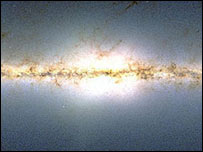Amit Oren

https://www.hayadan.org.il/milkywayage200804.html
A group of researchers who worked with the giant telescope in Chile reports that the age of our galaxy is 13,600 million years, plus or minus 800 million years. The calculation was determined by measuring the amount of the beryllium element [Be] in two stars in a globular cluster. The percentage of beryllium in a star increases over time, so that it can be defined as a "cosmic clock" to calculate its age.
"This is the first time we have made an independent decision about this fundamental value," said team member Daniel Galli of the INAF-Observatorio di Arcetri in Florence, Italy. The researchers tested the concentration of beryllium in two stars: A0228 and A2111 in the globular cluster NGC 6397.
Among the oldest stars in the Milky Way galaxy are found in star clusters, mainly globular clusters [there are two basic types of star clusters: open and globular].
Generation gap
The stars in globular clusters were born in the same gas cloud and at the same time, but were not the same stars that formed in the Milky Way galaxy. This is known due to the low content of specific chemicals in these stars, which must have been synthesized at an earlier stage due to a supernova process that happened after a short and energetic stellar life.
As stated at the beginning of the article, by measuring the amount of beryllium in two dim stars in the globular cluster NGC 6397, an international group found the time differences between the formation of the first generation of stars in the Milky Way and those in the cluster.
The result: 200-300 million years. Various models indicate that the age of the stars in the cluster NGC 6397 is about 13,400 million years, hence: the age of the Milky Way galaxy: 13,600 million years, with a small deviation of 800 years - forward or backward.
Technical obstacles
In any case, the measurements were not fair. Beryllium is destroyed at temperatures above several million degrees.
When a star evolves towards the "red giant" stage, heat flow brings hot gas from its interior to meet stable gas in the star's atmosphere.
This dilutes the beryllium content in the upper layer of the star's atmosphere, and therefore - the "beryllium clock" method should only be used in less dense and developed stars, but such stars are very faint.
Using the UV-Visual Echelle Spectograph (UVES) on their 8.2 meter telescope, the astronomers working on the project said they were able to obtain beryllium measurements from the stars A0228 and A0221.
This work will be published soon in the next issue of "Astronomy & Astrophysics".
Translated by: Amit Oren
For news at the BBC
Yadan Astrophysics 2 - stars and galaxies
https://www.hayadan.org.il/BuildaGate4/general2/data_card.php?Cat=~~~927996069~~~181&SiteName=hayadan

2 תגובות
1. What is the relationship between the position of the moon in the sky and its observed size?
2. What is the connection between the appearance of the illuminated part of the moon and the Hebrew date?
I have a question. Do you have an exploration question about the moon?